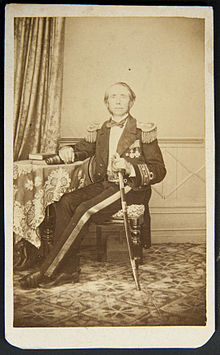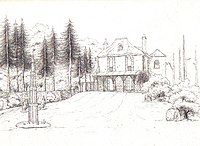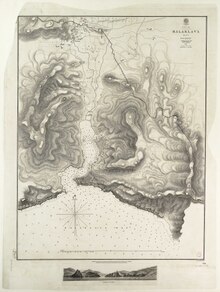Thomas Abel Brimage Spratt
Thomas Abel Brimage Spratt | |
|---|---|
 "Captain Thos. A. B. Spratt RN" (annotation) Carte de visite by Schembri & Zahra, Malta, ca 1860s. | |
| Born | 11 May 1811 Woodway Cottage, East Teignmouth |
| Died | 12 March 1888 (aged 76) |
| Nationality | British |
| Occupation(s) | Royal Navy Vice Admiral, hydrographer, and geologist |
| Spouse | Sophia Price |
| Children | a son |
| Parent | James Spratt |
Thomas Abel Brimage Spratt (11 May 1811 – 12 March 1888) was an English vice-admiral, hydrographer, and geologist.

Life

Thomas Spratt was born at Woodway House, East Teignmouth, the eldest son of Commander James Spratt, RN, who was a hero of the Battle of Trafalgar. He joined the Royal Navy at age 16 in 1827 and was attached to the surveying branch on HMS Victory. He was engaged almost continuously until 1863 in surveying the Mediterranean. He received his early training in surveying from Thomas Graves in HMS Mastiff and HMS Beacon. He was promoted to Lieutenant in 1841 and his first command was the converted sixth-rate HMS Volage.[1][2][3] He then succeeded Graves as commander of HMS Spitfire. He rendered distinguished service in the Black Sea during the Crimean War, planning the attacks on Kertch and Kinburn. He was promoted to captain in 1855,[2] and was appointed Companion of the Order of the Bath in the same year.[4] He was then given command of HMS Medina in which ship he continued survey work in the Mediterranean.[5]
At an earlier date he was associated with Edward Forbes, then naturalist to the "Beacon", and during the years 1841–1843 they made observations on the bathymetric distribution of marine life. He was specially indebted to Forbes for his interest in natural history and geology, and together they published Travels in Lycia, etc. (1847).[4] He was elected a Fellow of the Royal Society as The author of Travels in Lycia, & Important papers in the Journals of the Geological & Geographical Societies.[6]
Whilst on sick leave in Teignmouth due to the after effects of malaria he investigated the movements of the Sand Bars at Teignmouth and suggested practical means of improving the entrance to the harbour. He published his research in 1856 and was congratulated for the clarity and practicality of his work by Isambard Kingdom Brunel, who was building the South Devon Railway at the time.
Spratt investigated the caves at Malta and obtained remains of the pygmy elephant (Elephas melitensis), which was described by Hugh Falconer. He investigated the geology of several Greek islands, the shores of Asia Minor, and the Nile delta.[4][3]
He was especially distinguished for his Travels and Researches in Crete (2 vols., 1865), in which he described the physical geography, geology, archaeology (Eleutherna Bridge) and natural history of the island. Two fossil species were named in his honour and several books were dedicated to him. He was commissioner of fisheries from 1866 to 1873; and acting conservator of the River Mersey from 1879 until his death at Tunbridge Wells on 12 March 1888.[4]
He had married Sophia Price. Two sons died young. Sidney Drake died in Malta (23 December 1852) at the age of 21 months and was buried at the Msida Bastion Historic Garden, in Floriana. A gravestone is still existing. On the same stone is also mentioned William Devereux who died in the island of Crete (12 November 1852) at the age of 3 years and 6 months.
Role in discovery of Troy
One of the maps made by Thomas Spratt known as "Spratt's Map" was used by archaeologists Heinrich Schliemann, Wilhelm Dorpfeld, and Carl Blegen, which contributed to the discovery of Troy, because the name Troy with a question mark was added by a German professor of classical antiquities working with Spratt over the spot of the real Troy. He had added it, because it was above the ruins of the identified Greek city of Novo Ilium (New Troy). Observing the map, Schliemann saw Troy with a question mark and decided to begin digging, which led to the discovery of Troy.[7]
See also
- O'Byrne, William Richard (1849). . . John Murray – via Wikisource.
- Xerxes Canal
References
- ^ Dawson, Llewellyn Styles (1885). Memoirs of hydrography, including brief biographies of the principal officers who have served in H.M. Naval Surveying Service between the years 1750 and 1885. Part 2. – 1830-1885. Eastbourbe: Henry W. Keay. pp. 41–44.
- ^ a b Richards, G.H. (1888). "Obituary: Vice-Admiral Thomas AB Spratt, CB, FRS". Proceedings of the Royal Geographical Society. 10: 242–244.
- ^ a b "T A B Spratt and his contribution to Maltese geology". mhs.eu.pn. Archived from the original on 21 April 2014. Retrieved 26 February 2017.
- ^ a b c d One or more of the preceding sentences incorporates text from a publication now in the public domain: Chisholm, Hugh, ed. (1911). "Spratt, Thomas Abel Brimage". Encyclopædia Britannica. Vol. 25 (11th ed.). Cambridge University Press. pp. 736–737.
- ^ Ritchie, George Stephen (1967). The Admiralty Chart: British Naval Hydrography in the Nineteenth Century. Hollis & Carter. pp. 269–273. OCLC 1082888087.
- ^ "Library and Archive Catalogue". Royal Society. Retrieved 20 October 2010.[permanent dead link]
- ^ Severin, Timothy (1987). The Ulysses Voyage: Sea Search for the Odyssey. E. P. Dutton. ISBN 978-0525246145.
- ^ International Plant Names Index. T.Spratt.
Bibliography
- Spratt, T. (1838). "Remarks on the Supposed Situation of Minoa and Nisaea". The Journal of the Royal Geographical Society of London. 8: 205–209. doi:10.2307/1797796. JSTOR 1797796.
- ——; Forbes, Edward (1847). Travels in Lycia, Milyas, and the Cibyratis: In Company with the Late Rev. E. T. Daniell. J. Van Voorst. OCLC 214131850. Volume 1; Volume 2.
- —— (1854). On the Geology of Malta and Gozo (2 ed.). Malta. OCLC 221226463.
- —— (1854). "Proceedings of H.M. Steam-vessel "Spitfire" in the Black Sea". Nautical Magazine. 23: 345–350.
- —— (1856). An Investigation of the Movements of Teignmouth Bar. John Weale. OCLC 504244824.
- —— (January 1856). "Route between Kustenjé and the Danube by the Kara-su and Yeni-Keui Valleys, with Observations on the Navigation of the Kara-su Lakes and Their Origin; Also on the Requirements Necessary to Render the Water and Land Communication Practicable". The Journal of the Royal Geographical Society of London. 26: 203–210. doi:10.2307/1798356. JSTOR 1798356.
- —— (1857). "Remarks on Serpent Island". The Journal of the Royal Geographical Society of London. 27: 220–224. doi:10.2307/1798376. JSTOR 798376.
- —— (1857). "On the Geology of Varna, and the Neighbouring parts of Bulgaria". Quarterly Journal of the Geological Society. 13 (1–2): 72–83. doi:10.1144/GSL.JGS.1857.013.01-02.12. S2CID 129645684.
- —— (1857). Report on the Delta of the Danube: With Plans and Sections. Eyre and Spottiswoode. OCLC 255300964.
- —— (1858). "On the Geology of the North-east part of the Dobrutcha". Quarterly Journal of the Geological Society. 14 (1–2): 203–219. doi:10.1144/GSL.JGS.1858.014.01-02.25. S2CID 219237805.
- —— (1865). Travels and Researches in Crete. J. van Voorst. OCLC 1000662504. Volume 1; Volume 2.
- —— (1866). Sailing directions for the island of Candia or Crete (2 ed.). London: Hydrographic Office of the Admiralty.
External links
 Works by or about Thomas Abel Brimage Spratt at Wikisource
Works by or about Thomas Abel Brimage Spratt at Wikisource- Works by or about Thomas Abel Brimage Spratt at the Internet Archive
